 The Mineral
NEPTUNITE
The Mineral
NEPTUNITE
- Chemistry: KNa2Li(Fe, Mn)2Ti2Si8O24, Potasium Sodium Lithium Iron Manganese Titanium Silicate
- Class: Silicates
- Subclass: Inosilicates
- Uses: mineral specimens.
Specimens
PHYSICAL CHARACTERISTICS:
- Color is black to reddish black.
- Luster is vitreous.
- Transparency crystals are translucent to opaque.
- Crystal System is monoclinic; 2/m
- Crystal Habits include prismatic, elongated crystals with nearly square cross-sections. The terminations are modified and slanted dome faces. Also found massive and in disseminated grains.
- Cleavage is perfect in two direction at 80 and 100 degree angles.
- Fracture is splintery.
- Hardness is 5.5
- Specific Gravity is approximately 3.23 (slightly above average)
- Streak is reddish-brown.
- Associated Minerals are benitoite, natrolite, serpentine,
aegerine and joaquinite. - Other Characteristics: an internal red reflection can sometimes be seen through the prismatic crystal faces.
- Notable Occurrences include the famous San Benito Co., California site as well as Narsarssuk Greenland and the Kola penninsula, Russia.
- Best Field Indicators are crystal habit, internal reflection, streak, associations, color, and cleavage.
 Amethyst Galleries' Mineral Gallery MINERALS |
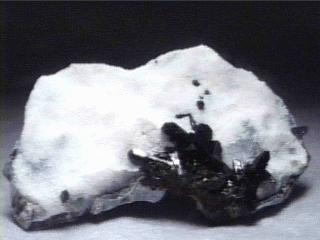
NEPTUNITE specimen nep-1
$ 65.00
$ 65.00
Dims: 2-1/2" x 1-1/2" x 1/2"
Wt: 20.3 g
Gem Mine, San Benito Co., California, U.S.A.
Several crystals of Neptunite make up the main cluster of this specimen. All appear black, with dark brown highlights that are visible at the cluster's base. The largest crystal is partially buried and measures 1/2" in length. All are clean and have little to no damage, with vitreous luster. There are 6 or 7 tiny crystals that are separated from the cluster, and show easily against the white natrolite matrix. Lastly, there are 2 benitoite crystals; both are heavily damaged and incomplete, with one on the edge of the flat matrix rock, and one on the reverse side, that is actually quite large(over 1/4" long on a side). The reverse also has a few broken remains of heavily weathered Neptunites that look a deep red-brown in color.

nep-1 ($ 65.00)
Gem Mine, San Benito Co., California, U.S.A.

NEPTUNITE specimen nep-3
$ 60.00
$ 60.00
Dims: 1-1/8" x 3/4" x 1/2"
Wt: 2.9 g
Gem Mine, San Benito Co., California, U.S.A.
A simple thumbnail specimen of Neptunite, this piece has two complete crystals on a natrolite crust. The larger crystal measures 1/2" x 3/16" x 1/8", and the smaller is proportionately half that size. Both have a black color and vitreous luster, and both are very well-formed, with clean faces and edges. The larger crystal has no visible damage, and the smaller has a large portion of a prism face missing, likely before the specimen was found, judging by its dirty state. There is a fragment of a broken crystal embedded in the natrolite nearby, and a tiny, incomplete crystal sticking out of the smaller complete near its termination.

nep-3 ($ 60.00)
Gem Mine, San Benito Co., California, U.S.A.
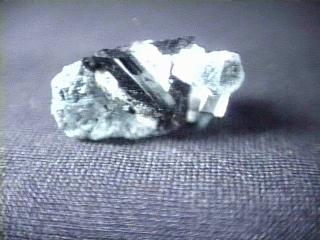
NEPTUNITE specimen nep-4
$ 52.00
$ 52.00
Dims: 1-3/8" x 3/4" x 3/4"
Wt: 7.5 g
Gem Mine, San Benito Co., California, U.S.A.
This thumbnail specimen has 3 complete crystals, two partials with complete terminations, and two shards of fragmented crystals. All visibly crystalline material has clean sides and faces, with a small amount of damage- none of the crystals are in absolutely perfect condition. Each is black in color and has red-brown highlights that are visible at points of damage, and has vitreous luster. The largest crystal is also the least damaged. It measures almost 3/4" in length, and about 1/8" in width and shows evidence of double-terminating amidst the small amount of damage that it has. All rests on a bed of natrolite that coats a weathered serpentine host rock.

nep-4 ($ 52.00)
Gem Mine, San Benito Co., California, U.S.A.

NEPTUNITE specimen nep-5
$ 50.00
$ 50.00
Dims: 1" x 1" x 1-1/8"
Wt: 9.1 g
Gem Mine, San Benito Co., California, U.S.A.
About 4 complete crystals erupt from the confusion of this thumnail specimen. Accompanying the complete crystals are a mass of partial crystals, partially buried crystals, and shards of broken crystals, one of which would have been the largest. As it is, the largest measures 1/2 inch long and approximately 1/8 inch wide. It has excellent form and no appreciable damage on its prism faces or edges. It and its smaller counterparts have a black color and vitreous luster, and rest on a natrolite crust that coats a weathered serpentine host rock.

nep-5 ($ 50.00)
Gem Mine, San Benito Co., California, U.S.A.
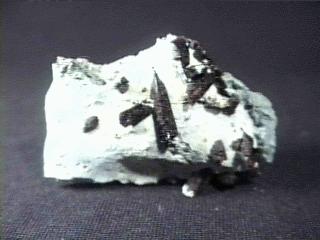
NEPTUNITE specimen nep-6
$ 50.00
$ 50.00
Dims: 2-3/4" x 1-7/8" x 1-1/8"
Wt: 2.54 oz
Gem Mine, San Benito Co., California, U.S.A.
Well over a dozen incomplete or damaged crystals infest the natrolite crust on this specimen. They all have been exposed, and are thus heavily weathered. This weathering brings out the red-brown highlights that Neptunite has and only shows through damage. Where original crystal faces show, they have a black color and vitreous luster.

nep-6 ($ 50.00)
Gem Mine, San Benito Co., California, U.S.A.
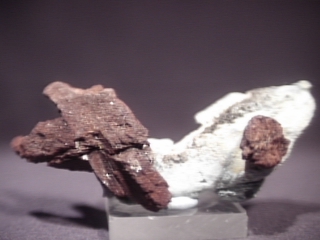
NEPTUNITE specimen nep-7
$ 27.00
$ 27.00
Dims: 3.1" x 1.4" x 0.9" (7.9 x 3.6 x 2.3 cm)
Wt: 19.7 g
Gem Mine, San Benito Co., California, U.S.A.
This specimen consists of a few large, intergrown Neptunite crystals on a pale gray host rock. They are heavily weathered, and along with the intergrowth, are thus heavily warped and have only a small amount of discernable crystal form. Their color is a deep red-brown, and their luster is waxy to pearly at best. I find this piece rather interesting because it brings out the natural color of Neptunite, which is often too deep to be discerned in complete, well-formed crystals that have the usual vitreous luster.

nep-7 ($ 27.00)
Gem Mine, San Benito Co., California, U.S.A.
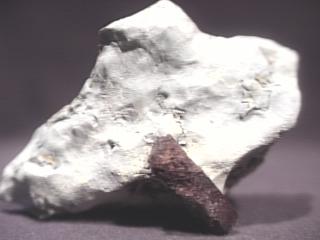
NEPTUNITE specimen nep-8
$ 32.00
$ 32.00
Dims: 3.4" x 2.1" x 1.3" (8.6 x 5.3 x 3.3 cm)
Wt: 2.63 oz. (74.8 g)
Gem Mine, San Benito Co., California, U.S.A.
The gray host rock of this specimen holds 2 weathered crystals of Neptunite. The larger of the two measures 1.0 x 0.3 x 0.3" (2.5 x 0.8 x 0.8 cm) and is more weathered than the smaller. Its termination is detectable but badly worn, as is one of its prism faces. The smaller crystal measures 0.9 x 0.3 x 0.3" (2.3 x 0.8 x 0.8 cm) and has a much better-defined crystal form and a complete, though partially buried, termination. Both show a deep red-brown coloration and a luster that ranges from waxy to vitreous, depending on the amount of wear.
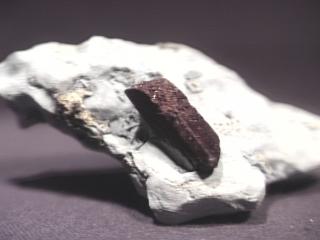

nep-8 ($ 32.00)
Gem Mine, San Benito Co., California, U.S.A.
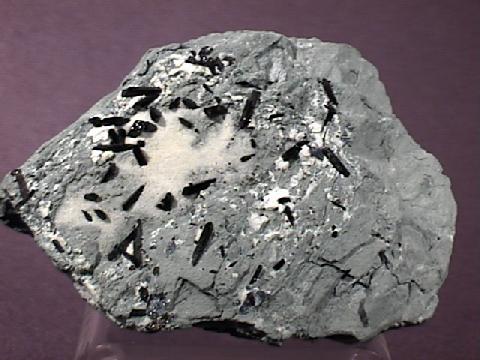
NEPTUNITE specimen nep-9
$ 40.00
$ 40.00
Dims: 3.0" x 2.3" x 1.1" (7.6 x 5.8 x 2.8 cm)
Wt: 3.77 oz. (107.1 g)
Gem Mine, San Benito Co., California, U.S.A.
This small hand specimen consists of several small Neptunite crystals that are resting near a patch of natrolite on a dull gray host rock. These crystals are quite small, measuring no more than 0.3" (8 mm) in length. They are generally in good condition, though there are several that are obviously broken and incomplete. Their monoclinic prismatic form is excellent, though; all have well-defined edges and very clean faces that show a bright, vitreous luster. They have the standard brown-black coloration of Neptunite, and are opaque to all intents and purposes. There are at least 5 benitoite crystals accompanying them, two of which are undamaged, but they are very small (2mm in diameter or less) and are either incomplete or partially embedded in the host rock. The natrolite crust appears to be weathered and shows no discernable crystal form.
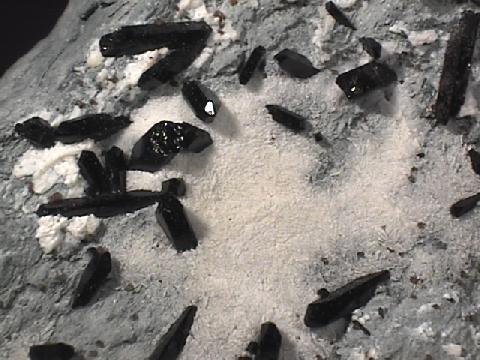

nep-9 ($ 40.00)
Gem Mine, San Benito Co., California, U.S.A.
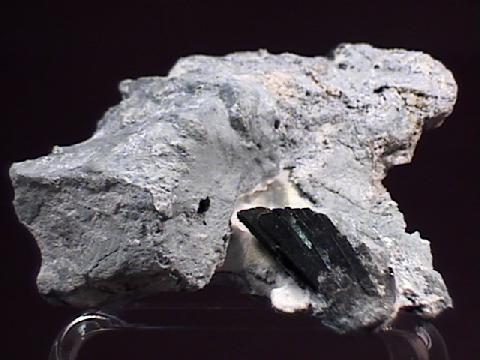
NEPTUNITE specimen nep-10
$ 95.00
$ 95.00
Dims: 2.5" x 2.2" x 1.5" (6.4 x 5.6 x 3.8 cm)
Wt: 2.83 oz. (80.3 g)
Gem Mine, San Benito Co., California, U.S.A.
The Neptunite on this specimen confuses me. It is one of those parallel associations that has the characteristics of both an individual crystal and a cluster of crystals. For all intents and purposes, I will address it as a crystal. It has dimensions of 0.9 x 0.4 x 0.3" (2.3 x 1.0 x 0.8 cm) and is in excellent condition, showing no damage. Its monoclinic prismatic form is complex, as the "crystal" appears to consist of many crystals that are intergrown and has many exposed edges and faces. It has a black color and a vitreous luster, and is completely opaque. It rests on a large base that is made up of compact natrolite and a soft, gray host rock. There is another partly exposed cluster of Neptunites elsewhere on the host rock, but this cluster is mostly buried under some of the gray host.
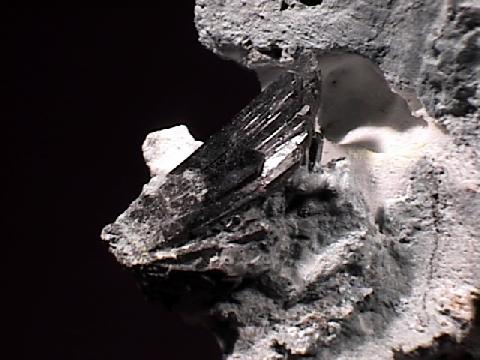

nep-10 ($ 95.00)
Gem Mine, San Benito Co., California, U.S.A.
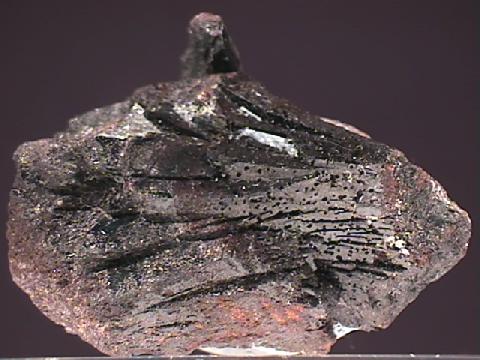
NEPTUNITE specimen nep-11
$ 60.00
$ 60.00
Dims: 1.8 x 1.6 x 1.3" (4.6 x 4.1 x 3.3 cm)
Wt: 1.7 oz. (49.3 g)
Gem Mine, San Benito Co., California, U.S.A.
This large thumbnail specimen consists of a mass of warped, damaged, and heavily intergrown prismatic Neptunite crystals. These crystals have a few discernable edges and faces, but cannot be considered as individuals. All are missing terminations due either to weathering or damage, and their faces and edges, though definable, are slightly worn and noticeably curved- however, they still possess a noticeable pearly-to-vitreous luster. All have a deep black-brown coloration where they are least weathered, but have a paler, reddish-brown coloration where weathering is most severe. Needless to say, all are completely opaque. The dull, pale gray host rock on which they rest is also highly weathered.
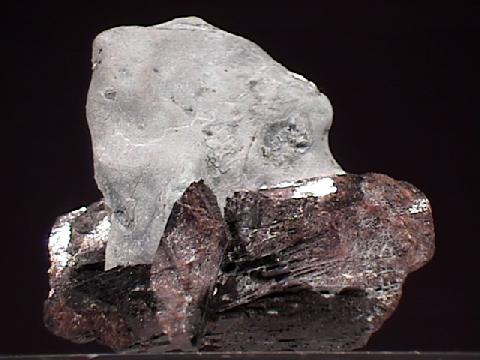

nep-11 ($ 60.00)
Gem Mine, San Benito Co., California, U.S.A.
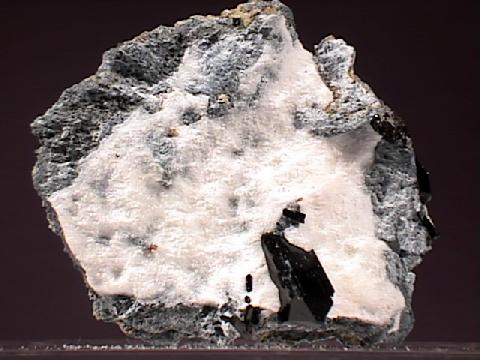
NEPTUNITE specimen nep-12
$ 90.00
$ 90.00
Dims: 1.7 x 1.5 x 1.0" (4.3 x 3.8 x 2.5 cm)
Wt: 26.3 g
Gem Mine, San Benito Co., California, U.S.A.
At least 15 Neptunite crystals rest in the artinite-encrusted host rock of this large thumbnail specimen. These crystals range in length from less than 0.1" (3 mm) to 0.5" (1.3 cm) and are generally in very good condition, though a few are noticeably damaged. Most of them are heavily intergrown and intersecting, but their monoclinic prismatic form is still excellent, with well-defined edges and smooth, clean faces that possess the standard vitreous luster. All have the classic black coloration with brown highlights and are, of course, opaque.
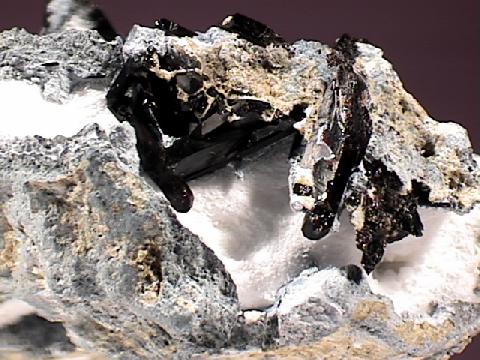

nep-12 ($ 90.00)
Gem Mine, San Benito Co., California, U.S.A.
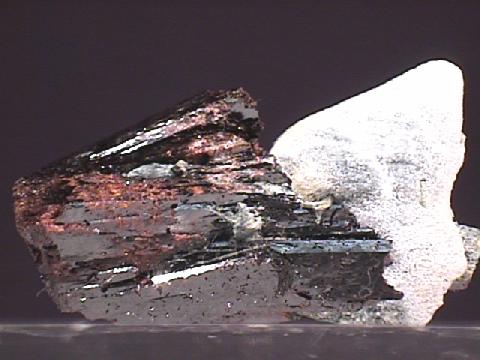
NEPTUNITE specimen nep-13
$ 27.00
$ 27.00
Dims: 1.4 x 0.8 x 0.6" (3.6 x 2.0 x 1.5 cm)
Wt: 11.2 g
Gem Mine, San Benito Co., California, U.S.A.
Several Neptunite crystals are heavily intergrown on this specmien, and make up most of its mass. These crystals do not exceed 1.0" (2.5 cm) in length and are all in good condition due to widespread light damage and slight weathering. Though intergrown, their monoclinic prismatic form is still fairly good, with well-defined edges and sometimes pitted but clean faces that often possess a bright, nearly adamantine luster.

nep-13 ($ 27.00)
Gem Mine, San Benito Co., California, U.S.A.
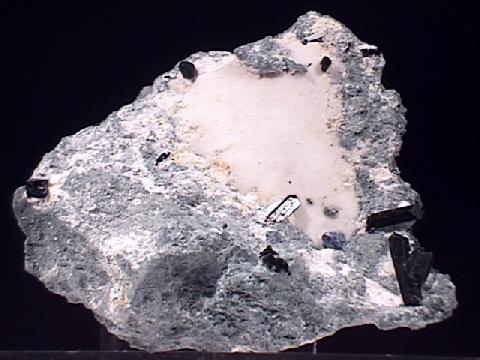
NEPTUNITE specimen nep-14
$ 35.00
$ 35.00
Dims: 2.5 x 2.0 x 0.8" (6.4 x 5.1 x 2.0 cm)
Wt: 1.63 oz. (46.3 g)
Benitoite Mine, San Benito Co., California, U.S.A.
This specimen consists of at least 10 Neptunite crystals that rest on a pale gray host rock. Only 5 or 6 of them, however, are more than 50% complete, and at least 2 of these are visibly damaged. The largest is intact, measuring nearly 0.5" (1.3 cm) in length, and like most of the others, it has excellent monoclinic prismatic form, with well-defined edges and clean faces. All are colored black with subtle red-brown highlights and have a dull vitreous luster. They are accompanied by 3 small, incomplete benitoite crystals that are rather worn but still have reasonably good hexagonal form. Their luster is very dull due to wear, but their royal blue color is standard for their species, and they glow brightly under shortwave ultraviolet light. All rest on or around a crust of white, massive natrolite.

nep-14 ($ 35.00)
Benitoite Mine, San Benito Co., California, U.S.A.
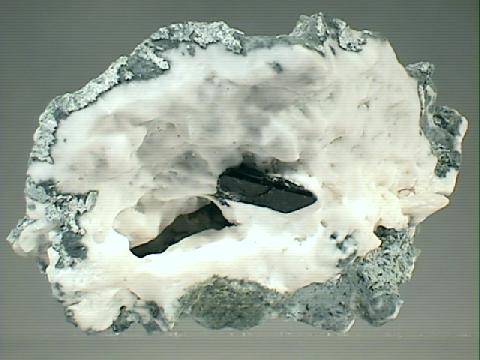
NEPTUNITE specimen nep-15
$ 28.00
$ 28.00
Dims: 3.2 x 2.7 x 1.6" (8.1 x 6.9 x 4.1 cm)
Wt: 5.12 oz. (145.4 g)
Benitoite Gem Mine, San Benito County, California, U.S.A.
This hand specimen consists of a single Neptunite crystal that rests on the natrolite-encrustsed base. This crystal has dimensions of 0.6 x 0.2 x 0.1" (1.6 x 0.5 x 0.3 cm) and is in excellent condition, showing little damage. Its monoclinic form is also excellent, and it has a black color with brown highlights and a vitreous luster. Given its color, it is essentially opaque.

nep-15 ($ 28.00)
Benitoite Gem Mine, San Benito County, California, U.S.A.
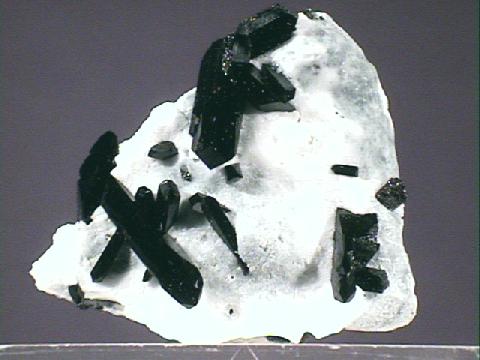
NEPTUNITE specimen nep-16
$ 60.00
$ 60.00
Dims: 1.1 x 0.9 x 0.6" (2.7 x 2.3 x 1.4 cm)
Wt: 6.2 g
Gem Mine, San Benito County, California, U.S.A.
At least 15 small Neptunite crystals rest on the gray base of this thumbnail specimen. These crystals range in length from less than 0.1" (3 mm) to 0.4" (1.0 cm), and are generally in good condition, though a few are damaged or broken and not quite complete. All have excellent monoclinic prismatic form and red-brown highlights that are visible against their black color when viewed under bright light. Their luster is vitreous, and all are essentially opaque. The host rock on which they rest is partly coated with a thin crust of massive, white natrolite. The piece is affixed inside a plastic specimen box with an adhesive putty.

nep-16 ($ 60.00)
Gem Mine, San Benito County, California, U.S.A.
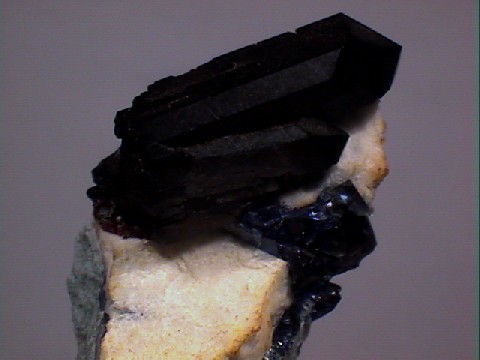
NEPTUNITE specimen nep-17
$ 40.00
$ 40.00
Dims:1.2x0.6x0.6" (3.0x1.5x1.5 cm)
Wt: 0.2oz. (7g)
Dallas Gem Mine, San Benito cty., California
A double crystal of neptunite comprises this specimen, perched on a massive natrolite crust with a few shards of benitoite crystals. All of this rests on a host rock of altered serpentine. The largest neptunite measures 0.7" (1.8cm) in length, and shows an excellent termination. The only damage to these neptunites is at the base, where they were broken off. The benitoite in the natrolite matrix stands out well if placed under a short-wave ultraviolet light. It fluoresces blue.

nep-17 ($ 40.00)
Dallas Gem Mine, San Benito cty., California
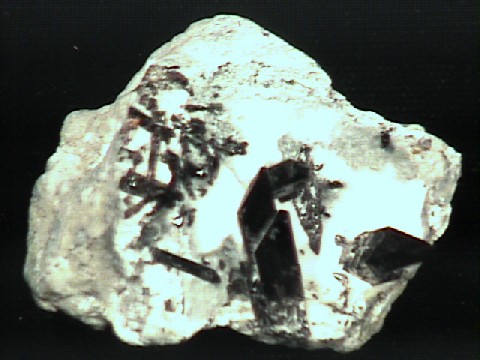
NEPTUNITE specimen nep-18
$ 65.00
$ 65.00
Dims: 1.46x1.14x0.91" (3.7x2.9x2.3cm)
Wt: 0.64oz. (18.1g)
Gem Mine, San Benito County, California, USA
This specimen has over 20 neptunite crystals, including a spray of tiny prismatic crystals, and several larger crystals. The largest 4 are in excellent condition, showing perfect terminations, an opaque black color, and a vitreous luster. These crystals present well against their white background.
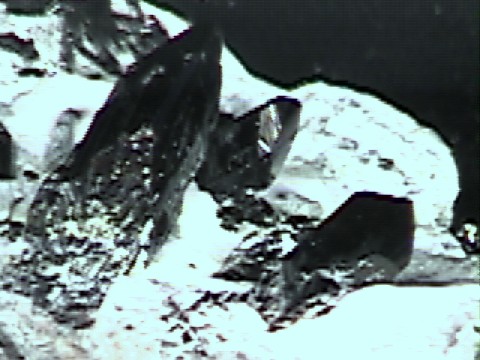

nep-18 ($ 65.00)
Gem Mine, San Benito County, California, USA